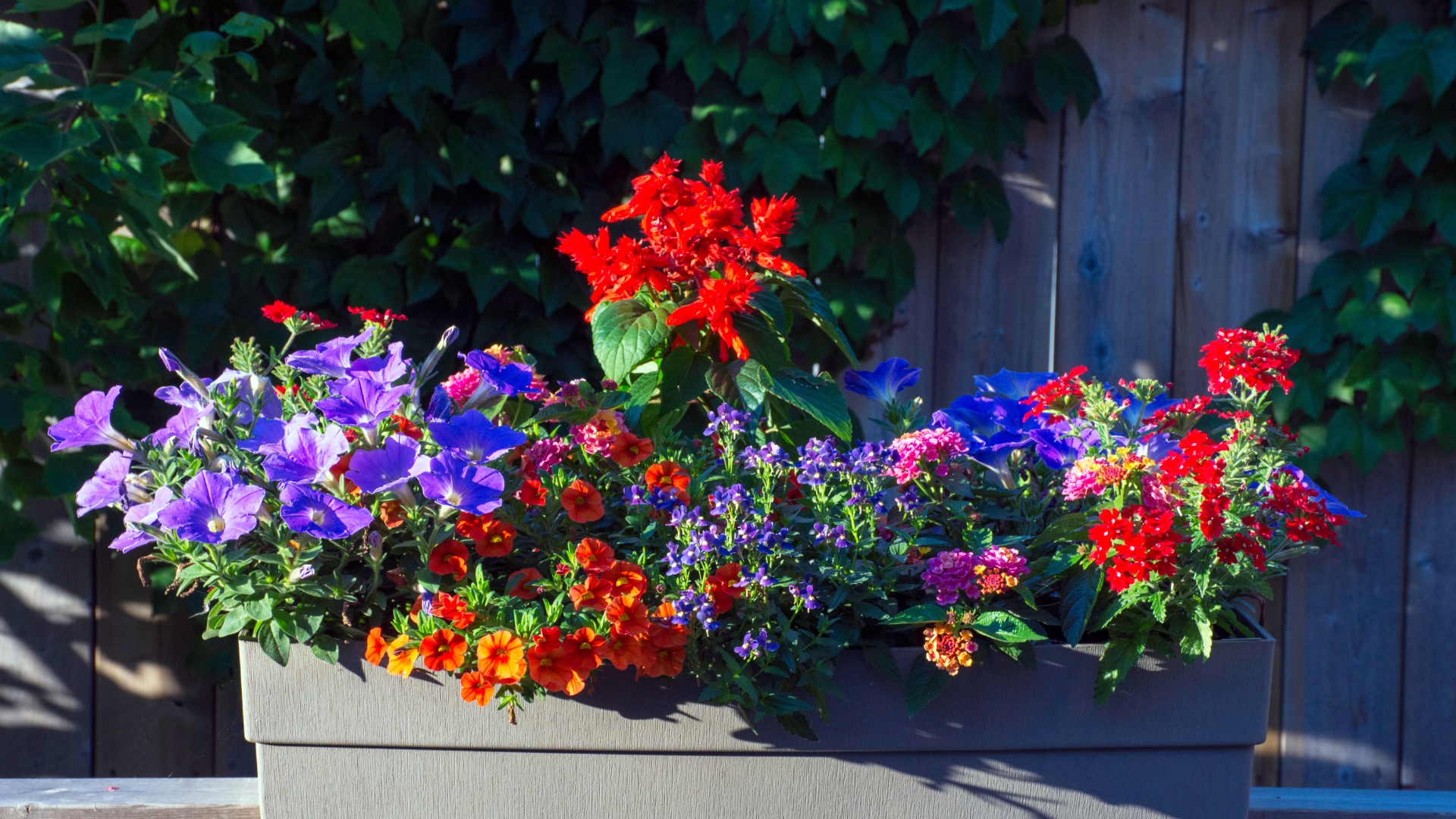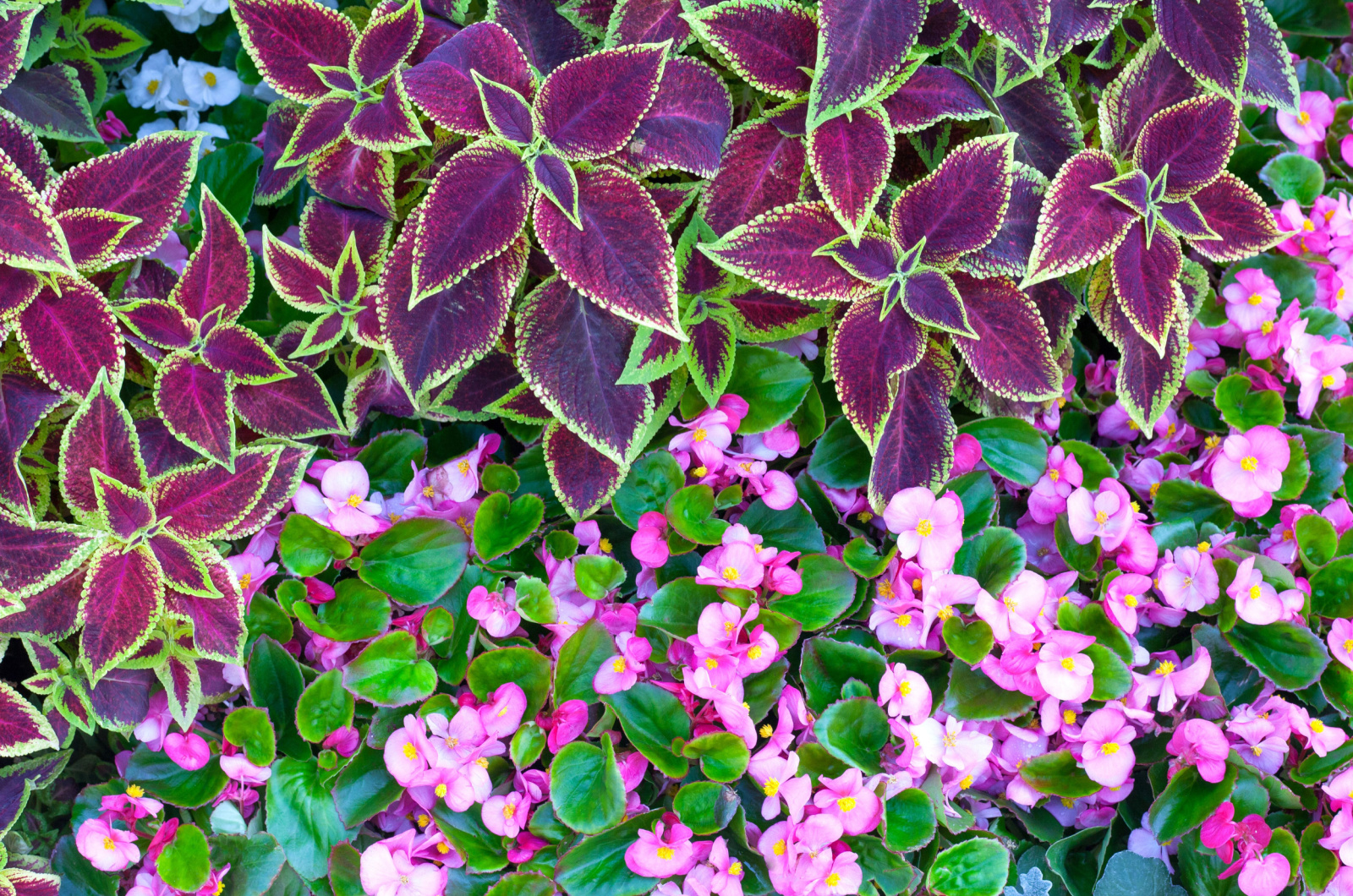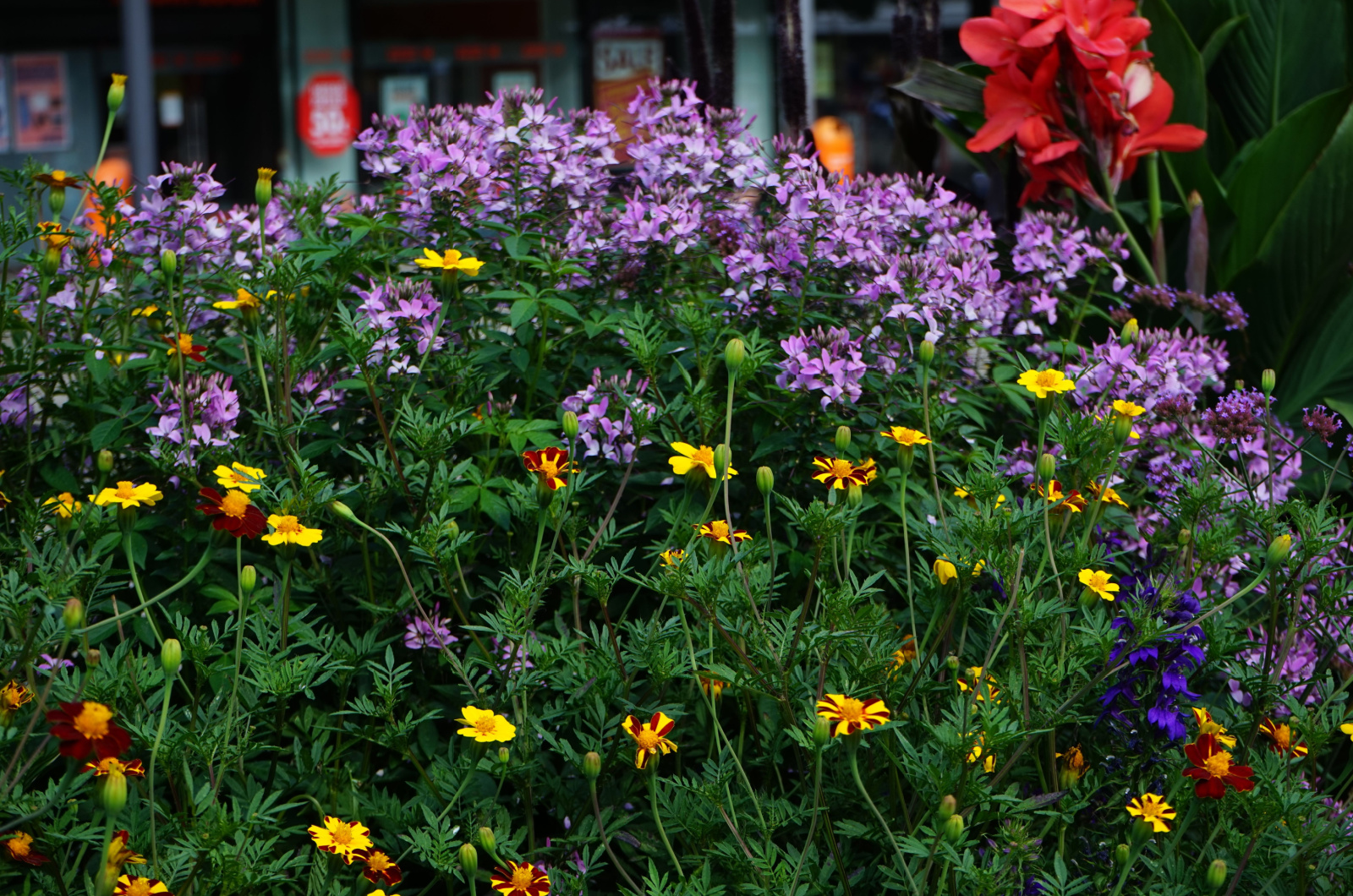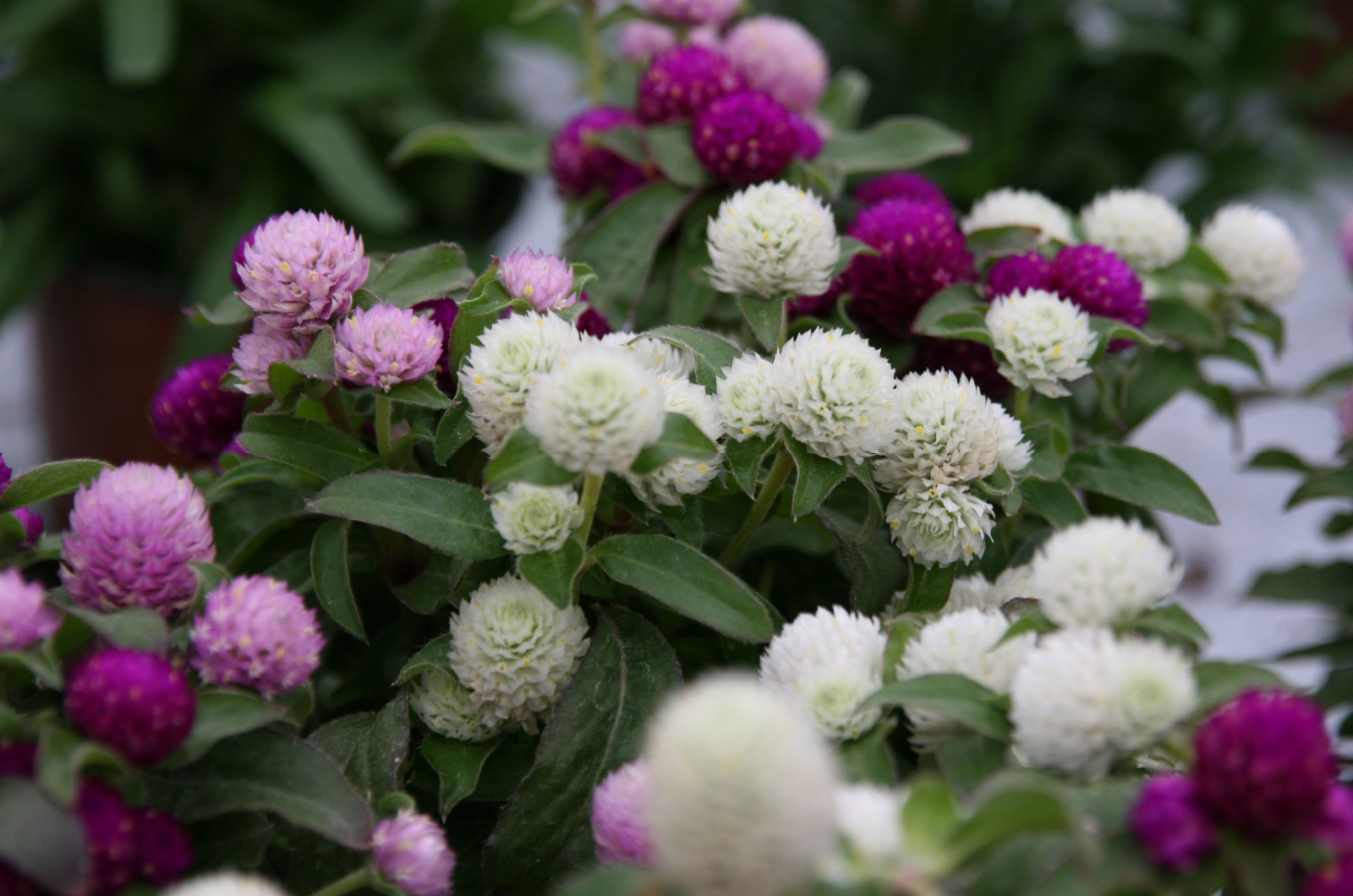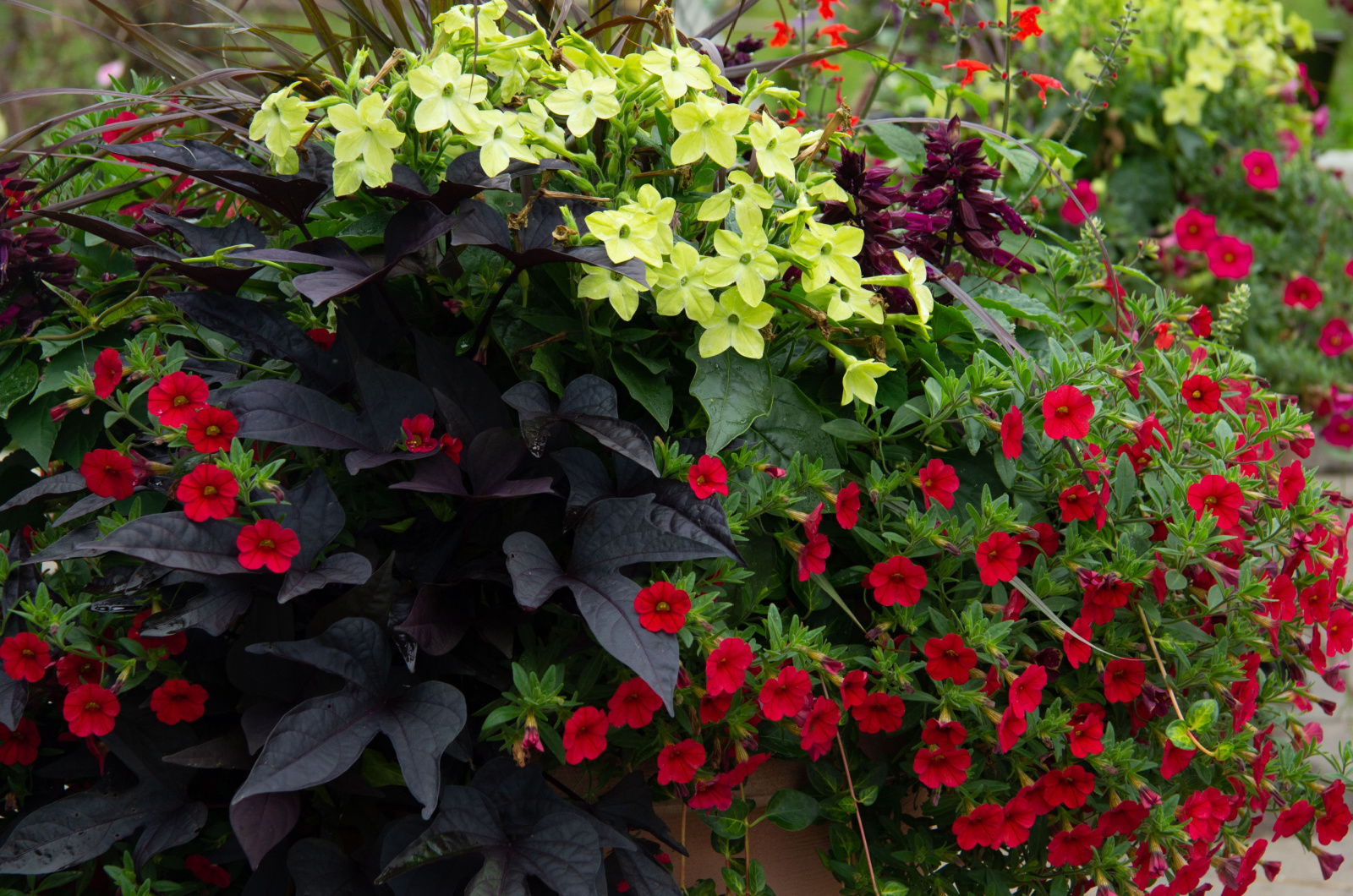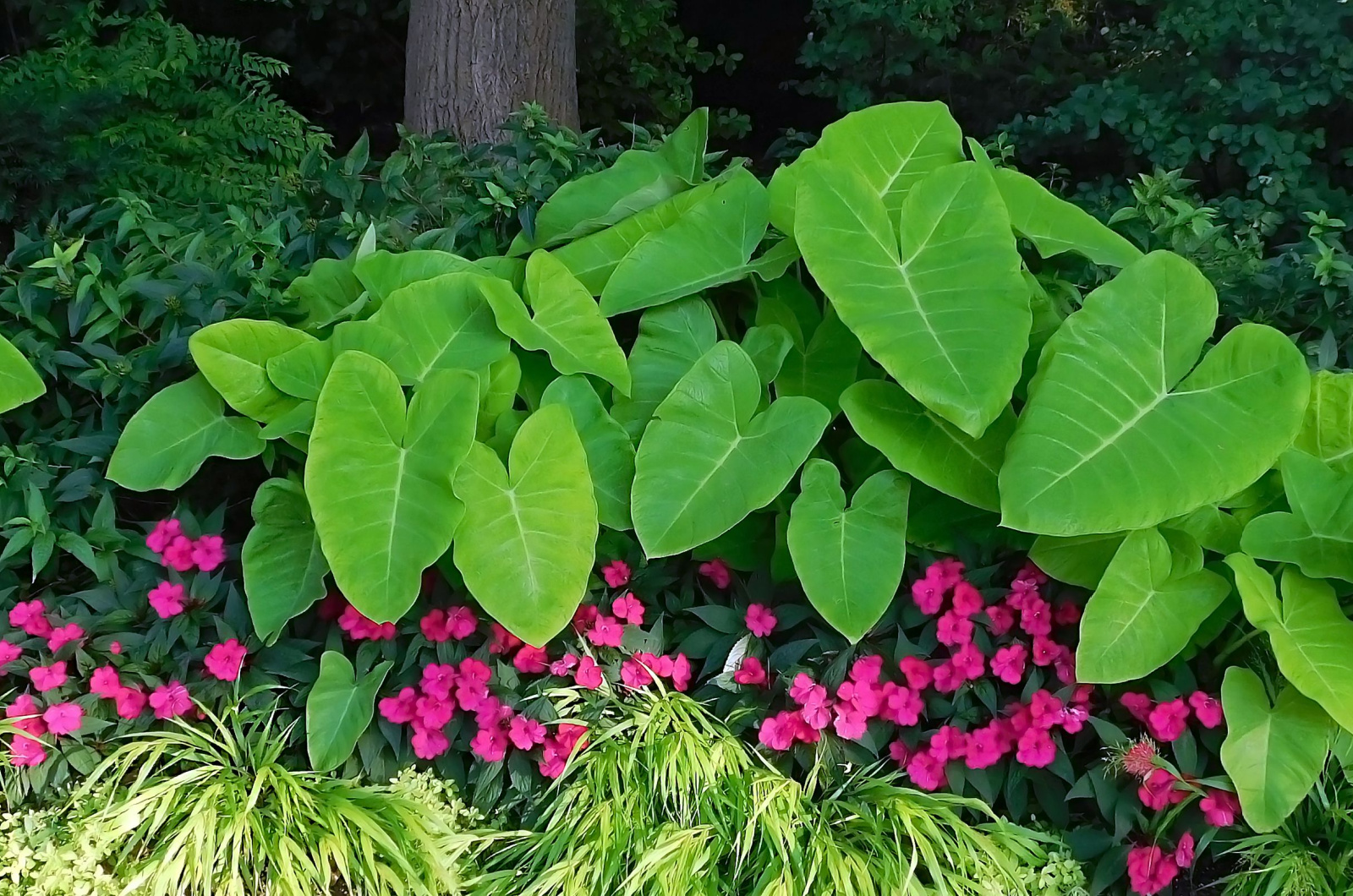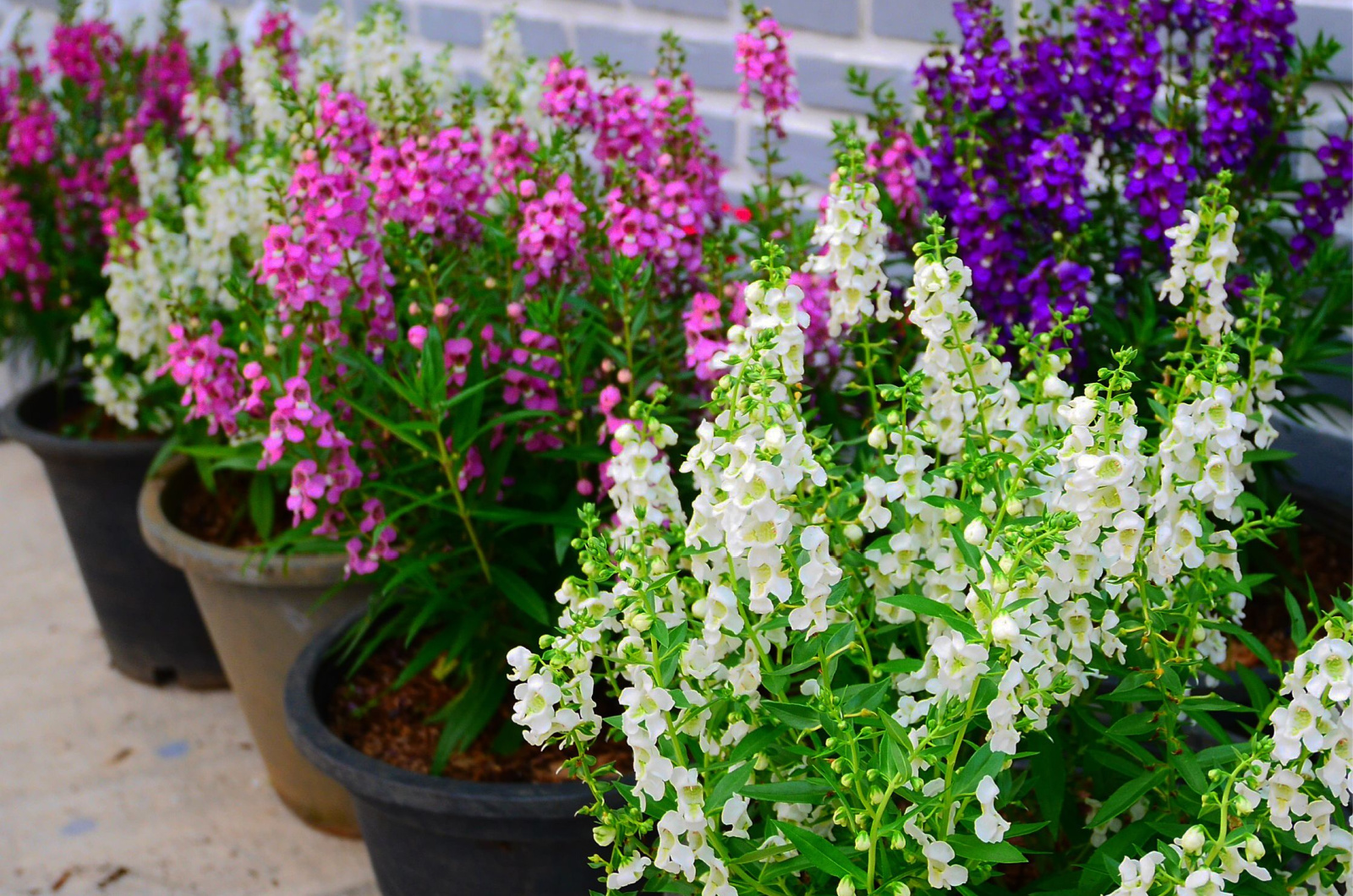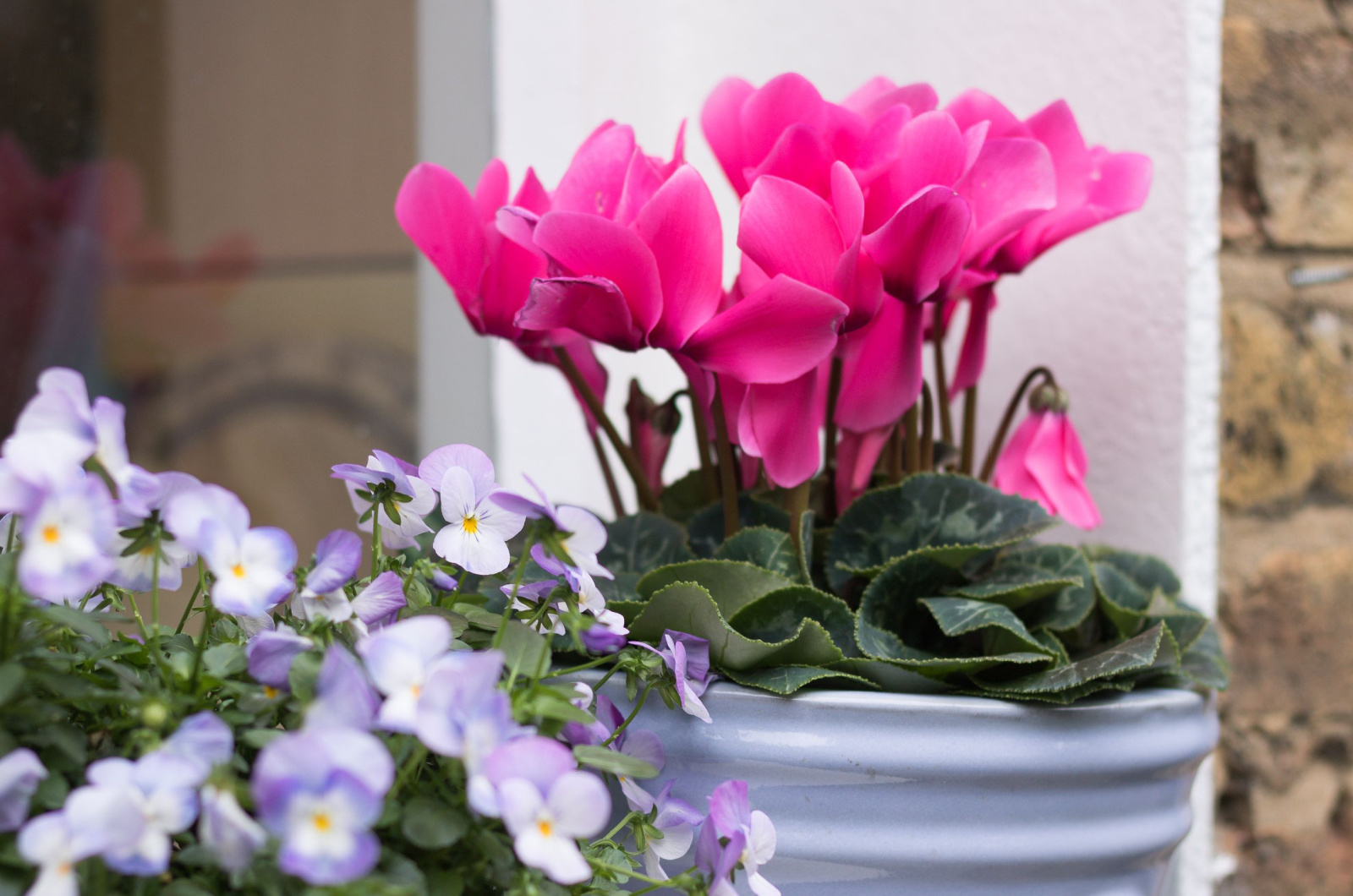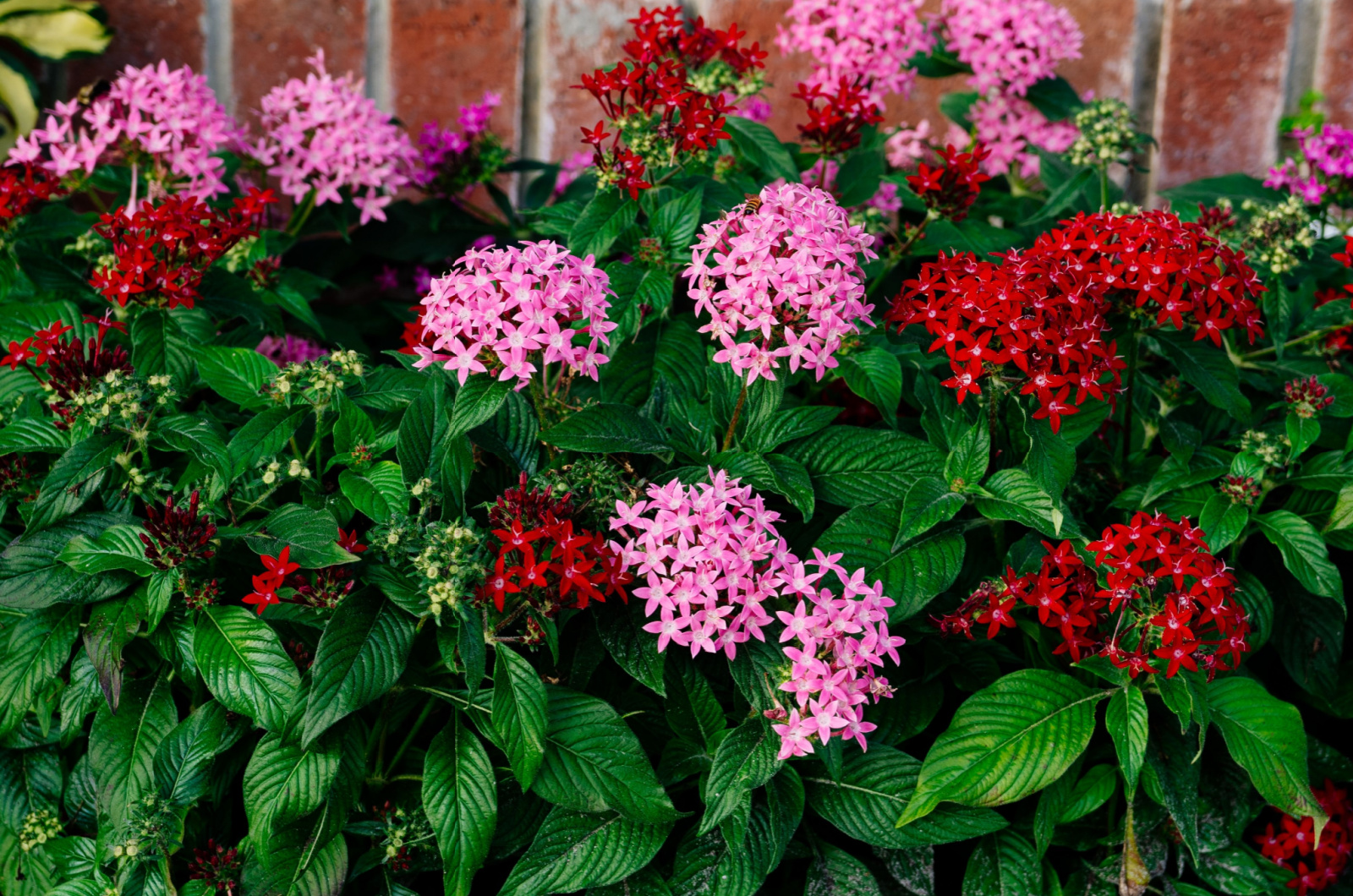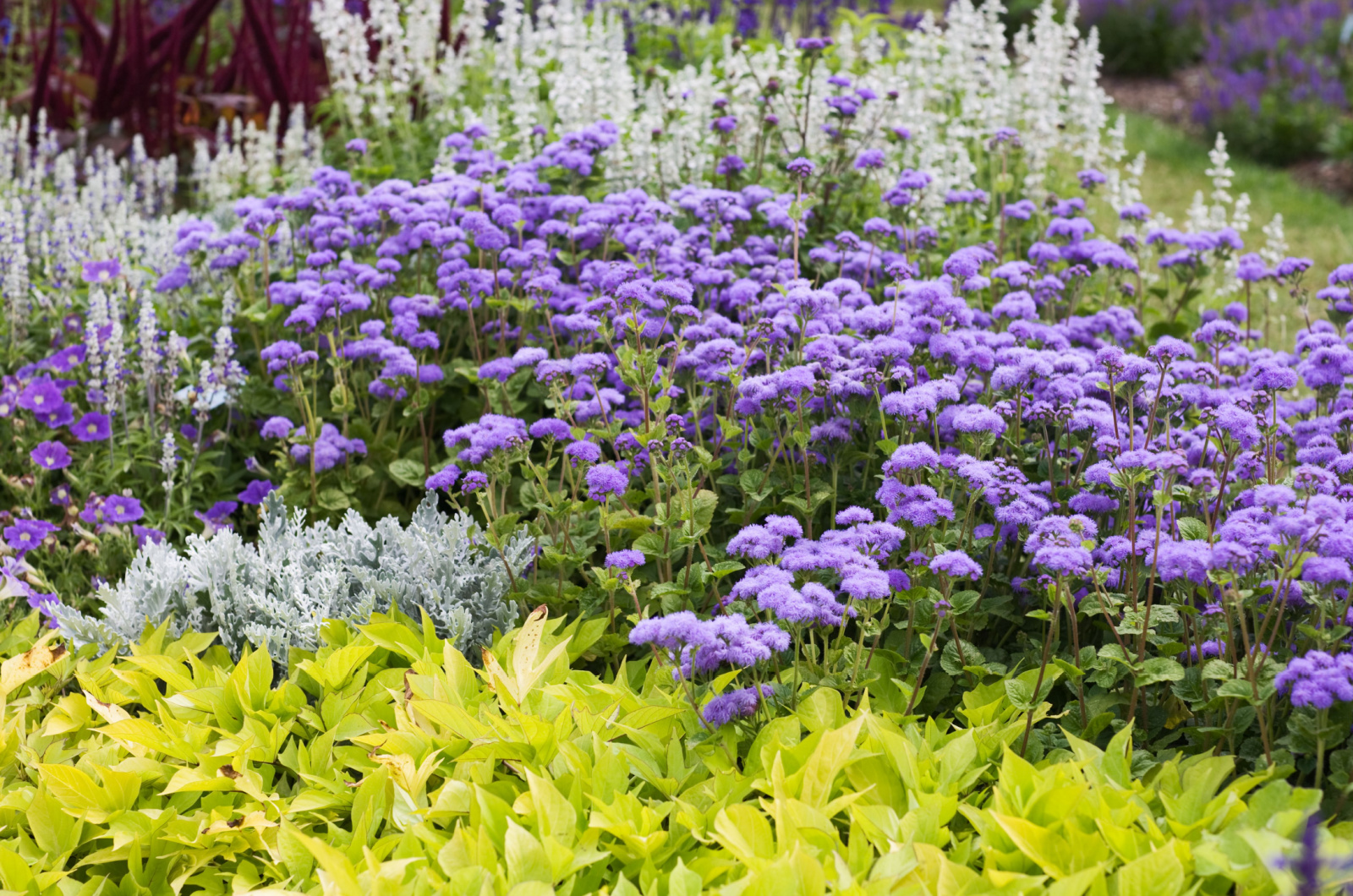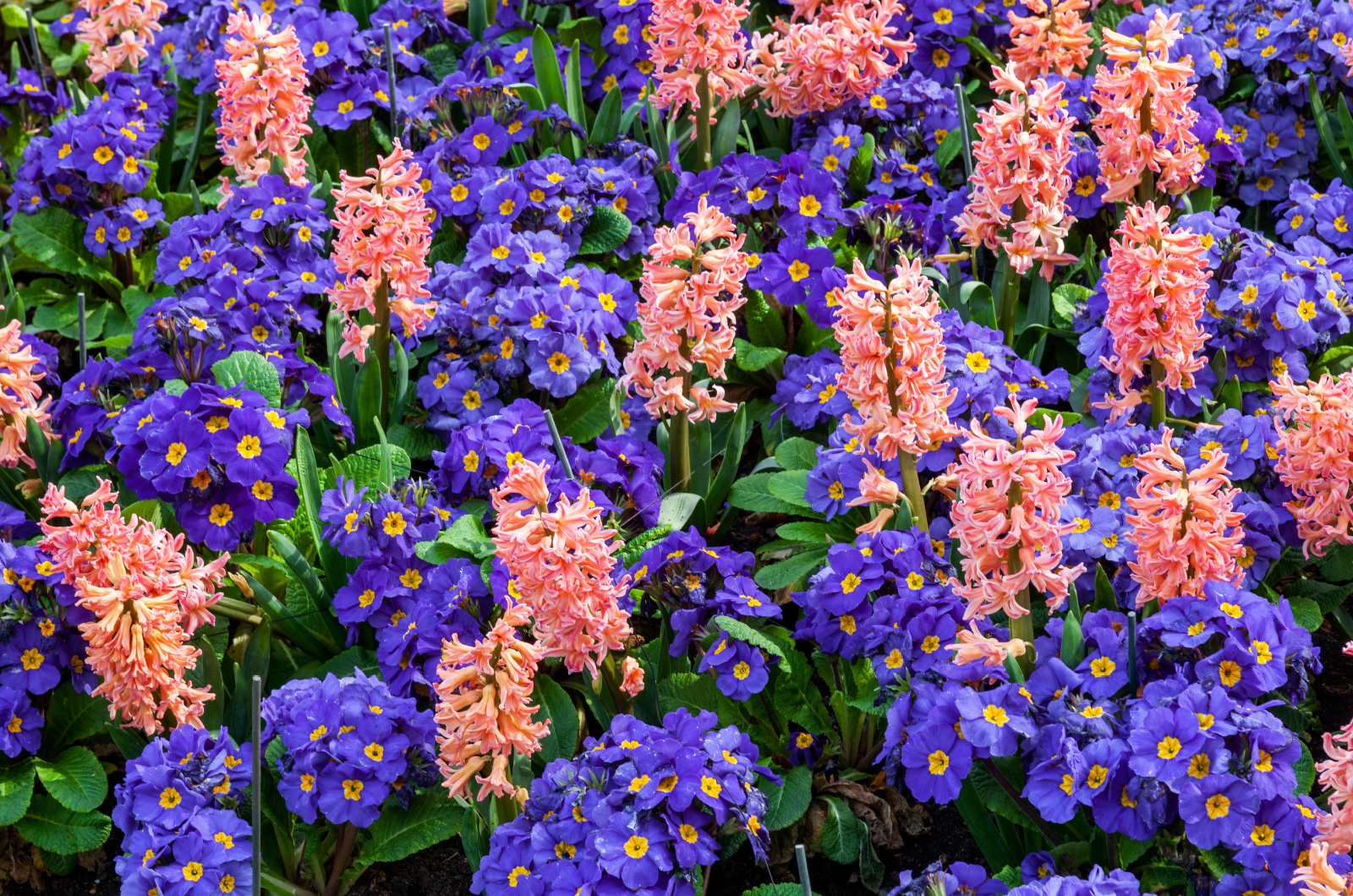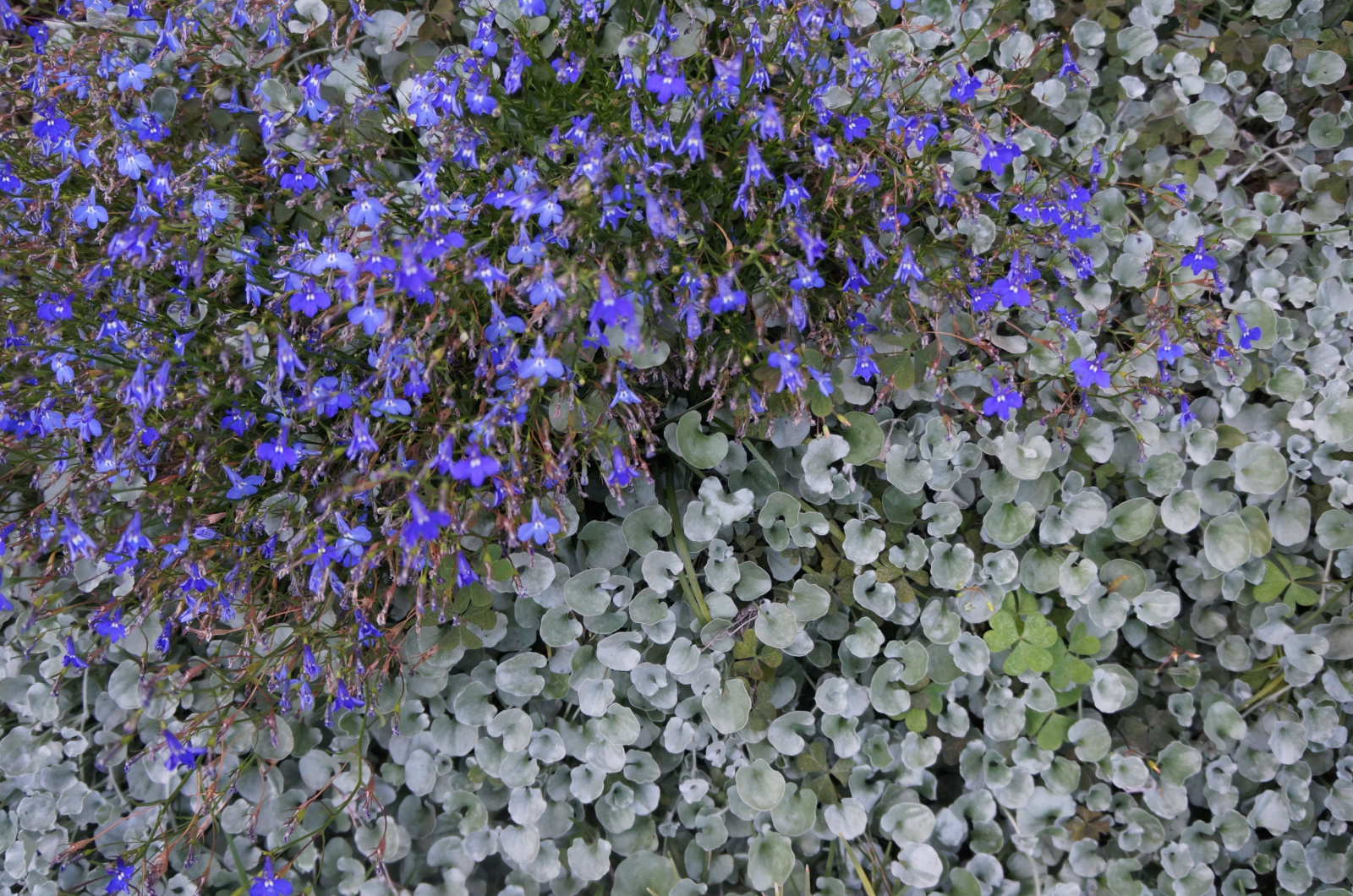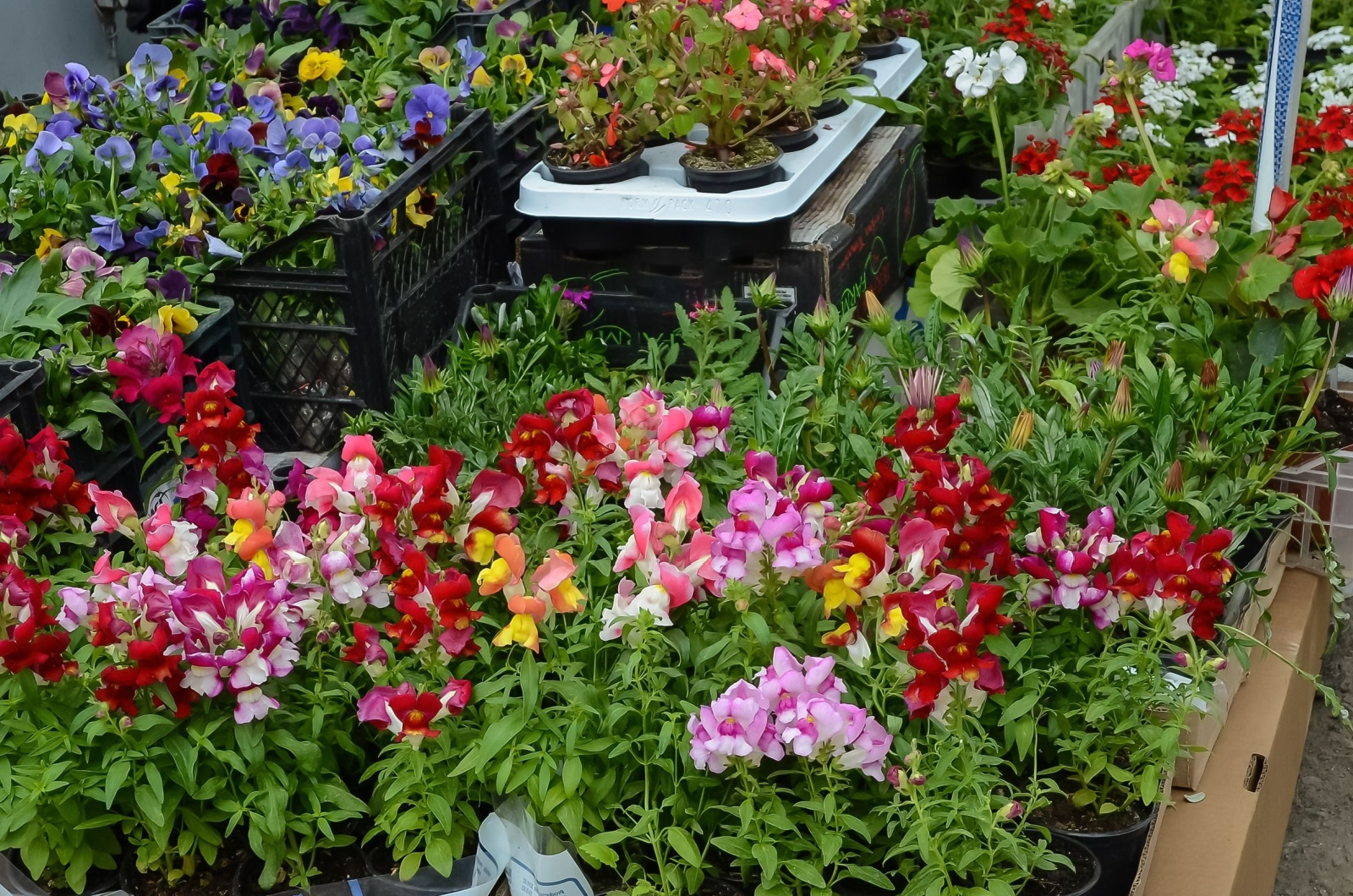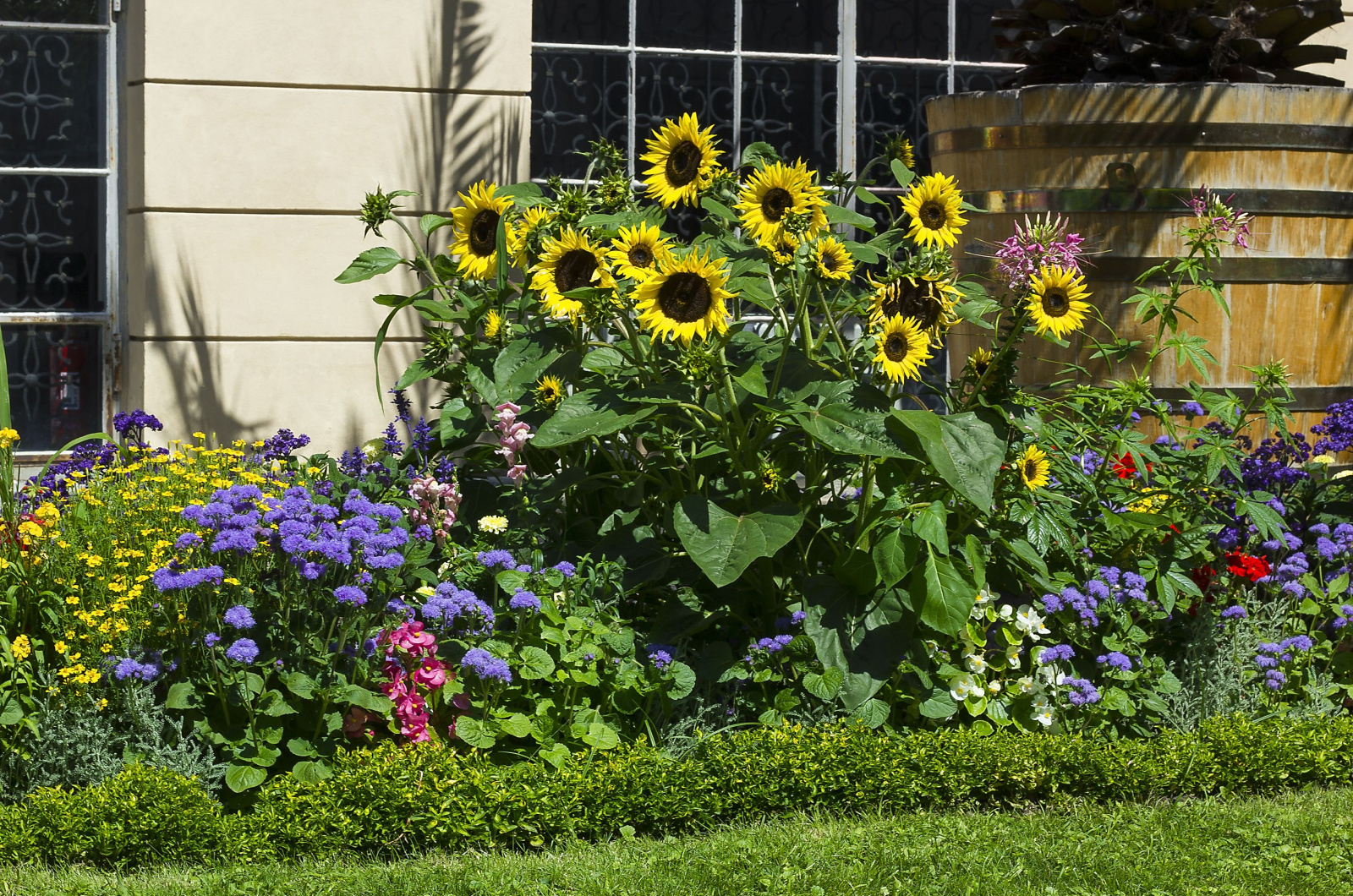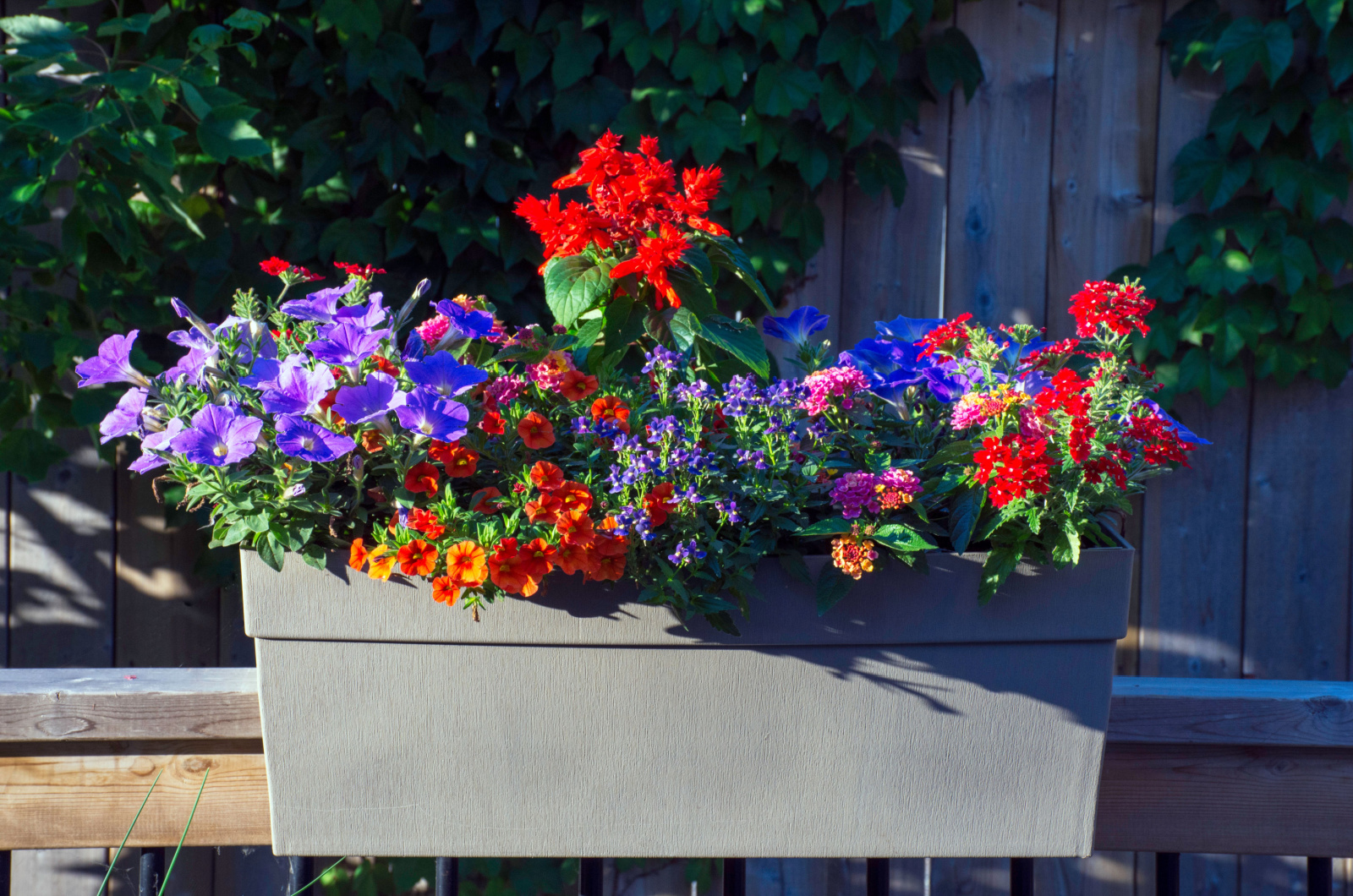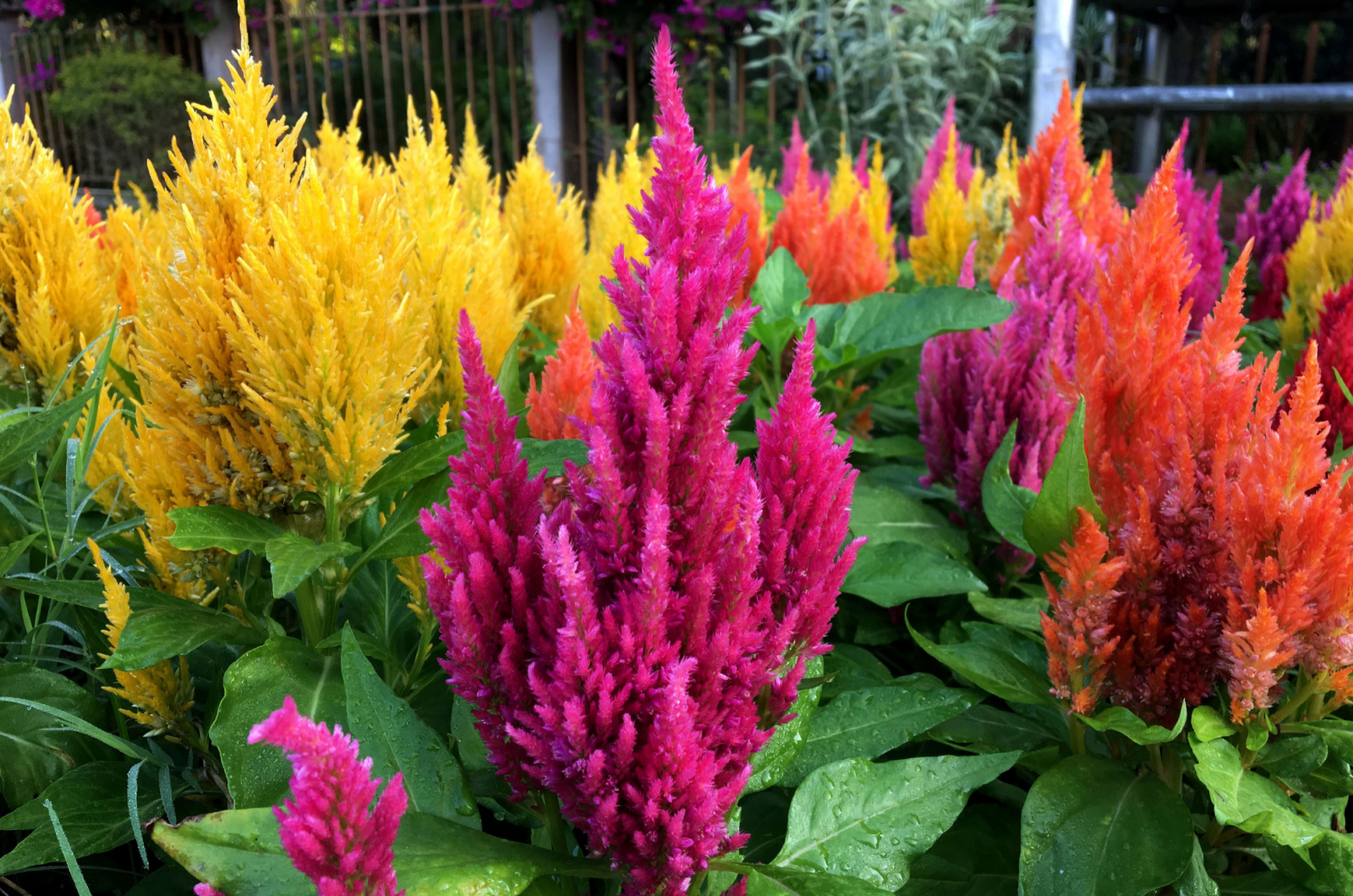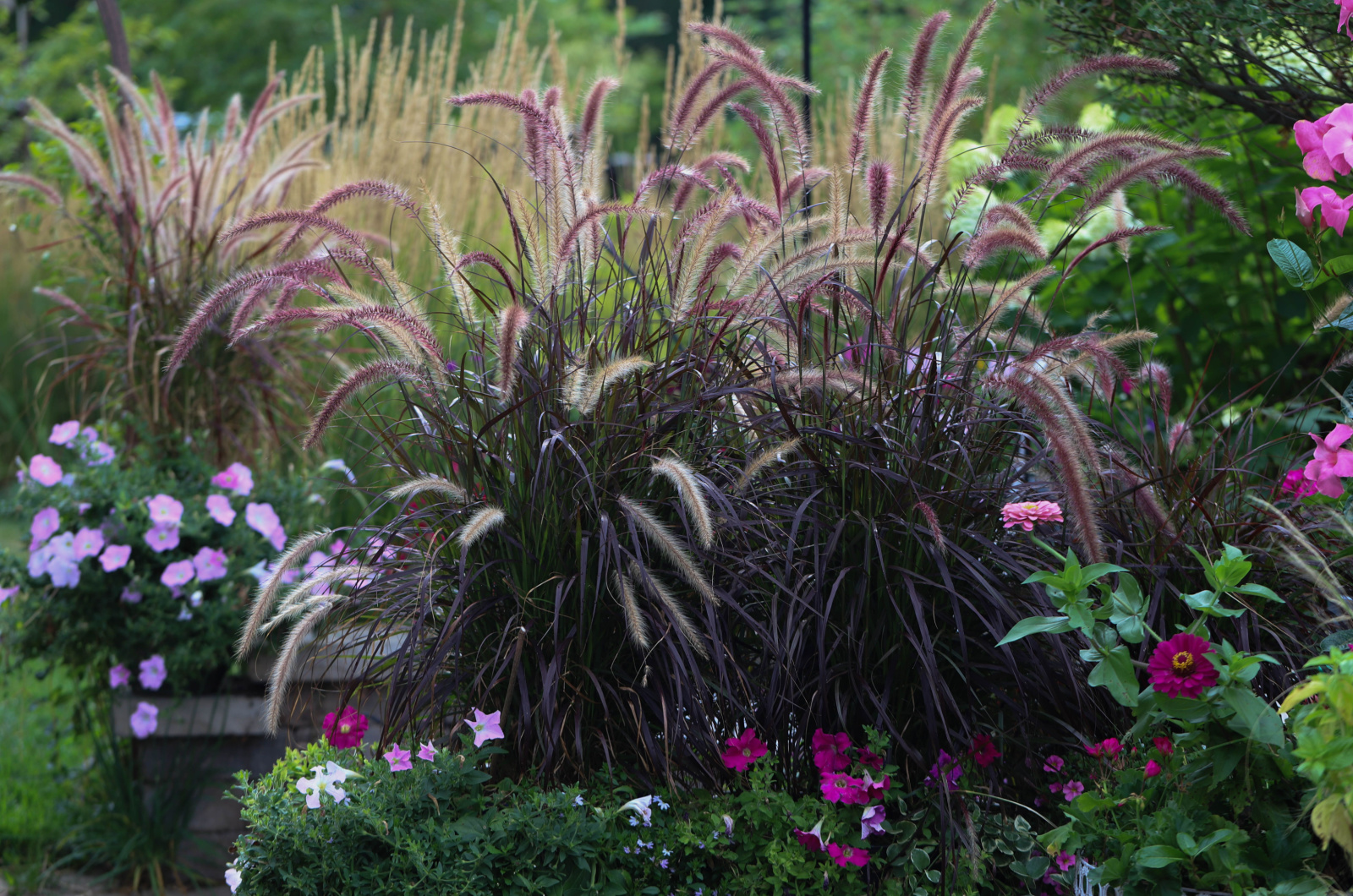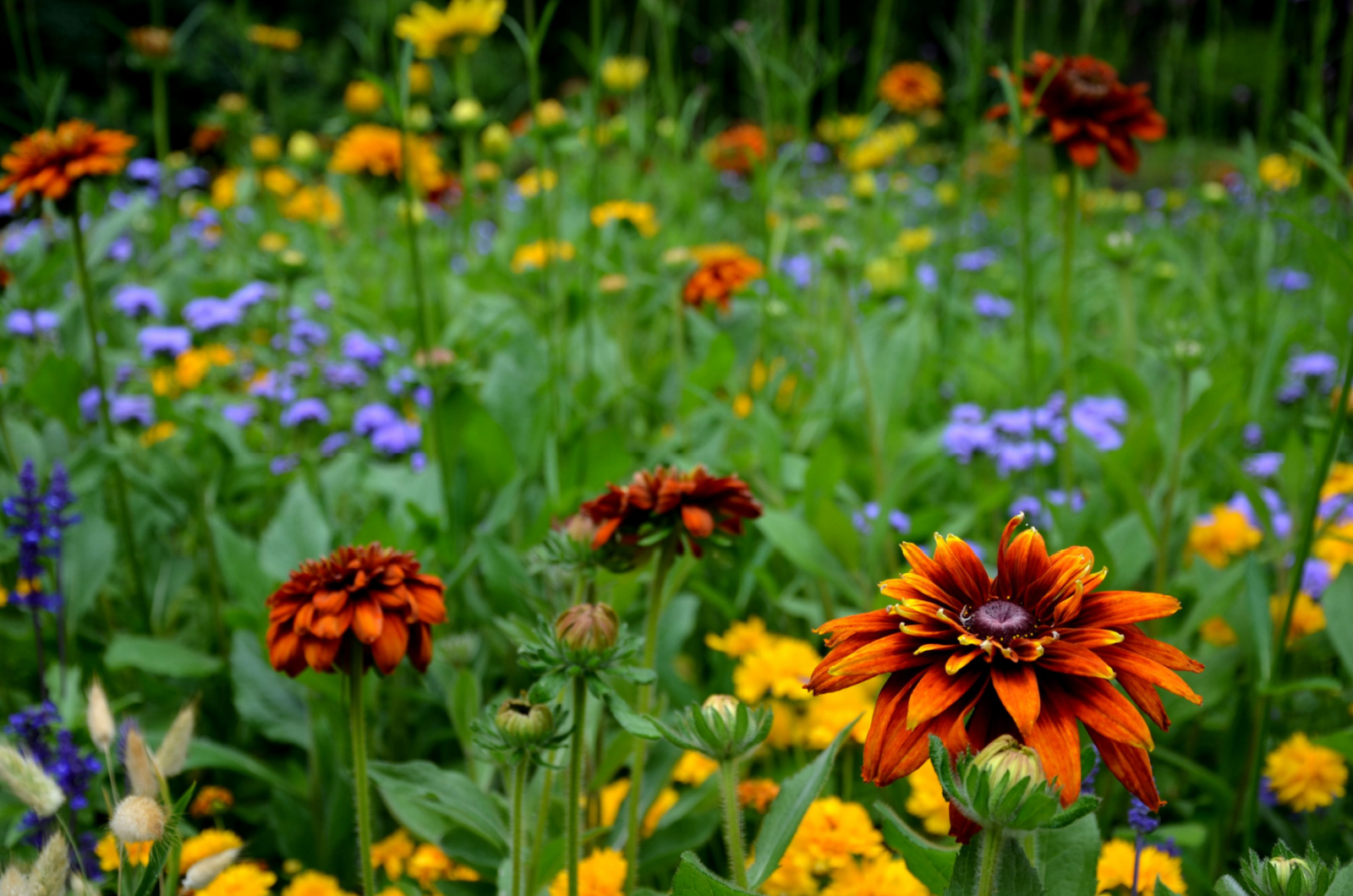Do you want your garden to look colorful and vibrant this season? If so, then you should definitely consider combining these flowering plants!
With long-blooming annuals, you’ll get a continuous burst of color and year-round allure to your garden. Besides, picking which flowers to grow together is the best part because you can get in touch with your creative side.
For a lively yearly show, mix flowers that really stand out together – opt for combinations with contrasting colors and textures to create a dynamic annual display!
Not only do these annual plants make your garden look great all year, but they also help butterflies, bees, and hummingbirds by providing them with nectar and pollen.
So, let’s see the prettiest flowering pairs and why you should grow them together!
1. Coleus & Begonia
Coleus is a perfect filler plant, able to brighten up any dark area with its vibrant foliage and tidy appearance!
It is known for its leaves that come in different shapes, sizes, and colors, but also its ability to grow and thrive in shaded areas. Coleus requires regular watering, and those kept in full sun might need some more water; unlike begonias, which can adapt to dry spots with heat.
Begonias are hardy annuals with thick, glossy leaves and pendulous flower clusters. The lush and colorful leaves of coleus pair up nicely with the vibrant begonia flowers, creating a striking contrast in the flower bed.
You can grow bronze-leaf begonias with sun-loving coleus in the sunny part of your garden, or graceful pink and white flowers for shaded flower beds.
Plus, they have different growth habits, which is why they can be used to achieve that layered look in the garden.
This might be useful: The Best Companions For Winter-blooming Begonias
2. Cleome & Marigolds
Marigolds are a popular annual flower appreciated for their looks, but also for the numerous garden benefits that come with them.
They produce prolific blooms with warm shades that fit perfectly with their deep green or purple foliage. Three types of marigolds are mostly used for flower bed combinations, including French marigold, Signet marigold, and African marigold.
On the other hand, cleomes are known for their pink, rose, white, or purple bloom clusters that grow on tall, upright stems – these add an informal and wild look to the garden.
The tall and elegant spikes of cleomes complement the compact and bushy nature of marigolds, resulting in a well-balanced and visually appealing combination.
Cleome’s pastel hues harmonize well with the bold and warm tones of marigolds, which ultimately creates a lively and cohesive color palette in the flower bed.
Both plants are known for attracting pollinators, so be prepared for a lot of bees and butterflies flying around the garden!
Here’s 5 Mind-Blowing Facts About Marigolds You Probably Didn’t Know
3. Gomphrena & Ageratum
Gomphrena, known for its pom-pom flowers that come in red, gold, white, and magenta colors, is a wonderful addition to your flower garden. They can be used in borders or flower beds, as long as they are kept in full sun and well-draining soil.
Opt for the ‘Firework’ cultivar as it produces tall stems and bright pink flowers with little tips of vibrant yellow. It will look amazing in flower arrangements, both fresh or dried.
Ageratum is known for its feathery bloom clusters that come in shades of blue, pink, white, and soft purple. Both gomphrena and ageratum offer small, compact blooms, creating a dense and abundant display of flowers.
The similar shades and textures of these flowers complement each other, forming a charming look in the flower bed.
You might find this interesting: 7 Common Mistakes That Are Ruining Your Flower Beds
4. Sweet Potato Vine & Nicotiana
Known for its broad leaves and trailing growth habit, sweet potato vines are often grown in containers, annual borders, or as ground covers. They grow vigorously and form roots easily.
When growing sweet potato vines, it’s important to regularly trim them to control their growth. These tropical-looking plants can adapt to periods of dryness, but shouldn’t be kept without water for too long, especially in periods of high heat.
Nicotiana is an annual plant that produces star-shaped trumpet flowers in red, green, white, and pink shades. The flowers have a sweet fragrance that attracts numerous pollinators to the garden.
Flowering tobacco, aka Nicotiana, grows well in well-draining, fertile soil and good moisture. Make sure to protect your flowering tobacco plant from direct sunlight during hot summer days.
Why grow them together?
Well, the trailing foliage of sweet potato vine adds a cascading effect, while Nicotiana contributes height and fragrant blooms, resulting in a multi-dimensional and aromatic combination!
5. Caladiums & Impatiens
Caladiums are unusual annual plants that are known for their distinct, arrow-shaped leaves that come in green, red, pink, or white colors. They are fast-growing plants with leaves that can last until freezing temperatures arrive.
These plants are super easy to grow – keep them well-watered until they are established, and keep on watering them regularly during the growing season.
Impatiens, on the other hand, are known for their sweet flowers that come in pastel pinks or whites, but also in bold and tropical colors such as red, yellow, coral, or magenta.
These are sun-loving plants that grow well in organically rich soils and consistent moisture during the growing season.
Since they have similar growing requirements, caladiums and impatiens are often grown in the same flower bed.
Caladiums boast colorful and uniquely shaped leaves, adding texture and interest, while Impatiens provide a sea of delicate, single-colored blossoms, creating a pleasing balance.
You might also like: 20 Nectar-Rich Native Plants For Attracting Hummingbirds
6. Angelonia & Mexican Heather
Angelonia plants produce colorful bloom spikes in different colors, including rose, white, pink, purple, and some are even bicolor!
They have bushy growth habits and long-lasting blooms that don’t need deadheading. Thriving in full sun and rich soils, angelonias are often added to annual beds or borders.
Mexican heather is another lovely annual plant that can be added to borders and also used for wonderful flower bed combinations!
These compact plants produce small leaves and lavender blooms. They bloom profusely and can be grown as evergreens in mild climates.
Moist, well-draining soil is a must for Mexican heather, while it can tolerate sun, salt, heat, humidity, and drought.
The vibrant colors of Angelonia flowers blend harmoniously with the dainty blossoms of Mexican heather, resulting in a delightful combination.
7. Cyclamen & Pansies
Heart-shaped leaves and colorful flowers are trademarks of cyclamen, a popular flowering plant that blooms from November through April. Popular hardy varieties, including Cyclamen hederifolium and Cyclamen coum, are often added to gardens.
Since they are low-growing plants, cyclamens are often added to borders, masses, flower beds, or along walkways.
Pansies also create lively borders with their large leaves and delicate blooms in blue, white, red, and purple colors. These are easy-to-care-for annual plants that might benefit from deadheading.
Since both thrive in cooler temperatures, both cyclamen and pansies make an excellent combination for fall and winter flower beds.
Also read: 5 Gorgeous Spring Flowers For Shaded Gardens
8. Pentas & Torenia
Pentas produce star-shaped flowers in pink, red, lavender, and white, making them the superstars of annual flower beds!
‘Butterfly’ pentas are mostly grown in gardens due to their extended blooming period and low-maintenance needs. Although pentas can tolerate shade, they thrive in full sun. You won’t have to worry about humidity, drought, heat, etc. because pentas can survive it all!
Torenias feature multi-colored bell flowers that, together with pentas, create a breathtaking flower display.
The ‘Summer Wave’ torenia cultivars are mostly grown because they can adapt to humid and hot environments. However, they’ll grow best when protected from afternoon sun and kept in moist soils (mulching helps here).
Both plants are also known to attract pollinators, thus improving the ecological balance of your garden while providing a vibrant and lively atmosphere!
You might like: 7 Flowers That Can Bloom Year Round
9. Bacopa & Calibrachoa
Bacopa is a showy low-growing plant that produces small, abundant flowers with yellow centers. Due to their prolific nature, you won’t have to deadhead the flowers.
These unique annuals can be damaged by extreme heat or dryness; if you live in warm climates, opt for hardy varieties such as ‘MegaCopa’ or ‘Tried and True’. Keep their soils moist and add some organic matter to help them thrive.
Calibrachoa is known for its petite bell flowers that look like mini petunias. Offering a wide range of colors, these blooms last from spring through late fall.
Keep calibrachoa plants happy and healthy by growing them in organic soil that also drains well. Grow them in garden beds with adequate drainage as they can easily get oversaturated.
Bacopa’s cascading growth habit complements the trailing nature of calibrachoa, creating a breathtaking flower display. Since both thrive in sunny conditions, they are a perfect combination for flower beds exposed to sunlight.
10. Dusty Miller & Heliotrope
Dusty miller is a striking annual plant known for its silvery-white and fuzzy leaves that cannot go unnoticed!
Grown as a cool-season plant, Dusty miller is often used in mild climates as a contrasting plant to deeper foliage and colorful flowers. This unusual plant thrives in full sun; it can also tolerate heat and drought.
Heliotrope is also a low-maintenance plant that can be grown in sunny gardens. It produces dark green foliage and deep purple flowers.
Keep in mind that heliotrope can’t do well in higher humidity as it is prone to powdery mildew – good air circulation and mulching will protect the plant. Also, avoid overwatering as it can easily attract fungi.
Why grow them together?
Dusty miller’s silvery foliage provides an elegant backdrop to the fragrant and colorful blooms of heliotrope, creating a well-balanced display. Plus, the fuzzy leaves of Dusty miller add contrast and texture to the smooth petals of heliotrope.
This might be useful: 15 Awesome Dusty Miller Companion Plants And How To Grow Them
11. Primrose & Stock
Primrose are herbaceous plants that bloom first – you’ll be able to spot these little flowers in late winter or early spring!
These plants feature clusters of tiny flowers on long stalks that usually bloom from February through May, with some varieties lasting into the summer. Green, purple, red, blue, pink, and orange flowers can be found on different primrose species.
With their low-growing habits, primroses are often found in borders, along walkways, or in container arrangements. Growing primroses is easy; all you have to do is provide them with adequate drainage and fertile soil.
Stock flowers are also cool-season bloomers that produce flowers on tall, upright spikes. The flowers are usually white, red, purple, or cream, and they can be single or double flowers on a stalk.
These plants can’t withstand the heat and will get easily damaged by extremely hot temperatures. It’s best to keep them in cool temperatures and well-draining soil.
Both plants are excellent for transitioning between seasons, providing early spring color with primrose and extending the bloom into late spring with stock.
The soft primrose colors complement the vibrant and rich colors of stock flowers, creating a visually pleasing and well-coordinated flower bed.
Also read: 25 Best Flowers For Early Spring And A Gorgeous Display
12. Lobelia & Dichondra ‘Silver Falls’
Lobelia are annual plants that produce blue tubular blooms and gray-green leaves from late spring all through frost. Different varieties might have dark blue, white, lavender, or even pink flowers.
Cutting lobelia back after the blooming period will improve its growth and development; ensure you keep this plant in full or partial sunlight and fertile soil that drains well.
Dichondra ‘Silver Falls’ is a dichondra variety grown for its small leaves on silvery stems that trail and form dense ground cover. Although these are low-growing plants, their runners can reach up to three or four feet long.
This dichondra species grows well in full to partial sunlight. It will grow well as long as it is kept in a well-draining soil; otherwise, this plant doesn’t have any special requirements.
These two annuals pair gracefully because they have similar needs, but also because the fine texture of lobelia’s flowers contrast beautifully the silvery vines of dichondra ‘Silver Falls’.
This might be useful: Discover The Perks Of Growing Dichondra Grass Instead Of A Traditional Lawn!
13. Geraniums & Sweet Alyssum
Geraniums are an all-time favorite garden plant for a couple of reasons: first of all, they produce vibrant flowers that bring texture to your annual flower display. Geranium blooms attract lots of pollinators and they pair up nicely with other annuals.
Besides delicate flowers, geraniums also have distinct leaves that combine perfectly with multi-colored flowers. They are often grown in the garden, but if you don’t have enough space, you can always grow geraniums in pots.
On the other hand, sweet alyssum is a petite plant that produces lovely white flowers from spring through fall. The flowers also have sweet fragrances that pollinators absolutely love.
Add sweet alyssum to a border or use it to contrast vibrant flowers such as geraniums. If you want a white-themed flower bed, you can combine these plants with dusty miller.
Related: 2 Ways Of Saving Geraniums In Fall And Keeping Them Alive During Winter
14. Snapdragons & Violas
Yellow, red, peach, pink, and coral bloom spikes are trademarks of snapdragons, annual plants often used in the cool season gardens. Not only do they make great cut flowers, but they also attract pollinators and grow well in pots.
You can choose between dwarf, medium, or extremely tall snapdragon varieties. Use dwarf varieties to fill out the front of your garden display and tall ones behind smaller annuals as a colorful background.
Additionally, violas also come in lots of colors and grow well in cool season gardens. Thanks to their compact growth and profusion of blooms, violas can be added to borders and also containers, window boxes, and hanging baskets!
There are so many different varieties you can choose from, so you might as well get creative and grow colorful flower bed combinations, or opt for a monochromatic flower display.
Since they both thrive in cooler gardens, snapdragons and violas are often grown together
Snapdragons provide vertical interest while violas offer a low-growing, spreading habit, creating a visually dynamic and layered flower bed.
Also read: 17 Well-behaved Vines For Your Arbors And Trellises
15. Sunflowers & Amaranth
We all know that sunflowers can make any garden look more cheerful, but combined with amaranth? This changes everything!
Sunflowers are known for their yellow, cream, garnet, or orange blooms that grow tall to try and reach the sun. They grow quickly from seeds and you might consider adding some sunflower companion plants to boost their growth and development.
Amaranth are known for their striking foliage and pendulous blooms that come in burgundy, magenta, gold, and coral shades. The most popular varieties include ‘Coral Fountain’, ‘Emerald Tassel’, and ‘Red Spike’.
Why grow them together?
The towering presence of sunflowers combined with the unique forms of amaranth creates a dramatic and eye-catching focal point in the garden.
Plus, they both thrive in sunny conditions, making them a well-suited pair for sun-drenched flower beds that demand attention.
This might be helpful: How To Harvest Sunflower Seeds After Blooming
16. Lantana & Red Salvia
Lantana, a low-maintenance plant that produces bursts of colorful flowers, is often added to flower beds. This plant can be grown as both a perennial or annual, depending on the hardiness zone you live in.
You can choose between a wide spectrum of colors, including pale peaches, pinks, yellow, oranges, or bright reds. Plant it in a location with full sun exposure and water it when the soil dries out.
To spice things up, you can also add red salvia. This plant originates from Brazil and is known for its tropical red-hot colors. It is also an easy-to-grow annual that produces heart-shaped leaves and long-lasting flower spikes.
Keep salvia in full sun and well-draining soil, and watch it grow and thrive!
These two plants are often paired up because lantana’s multi-colored blooms harmonize beautifully with the bold red spikes of salvia. In addition, they are both known for attracting pollinators.
You might like: Discover The 12 Best Border Plants For Your Garden
17. Celosia & Alternanthera
If you want to have a fire garden, you should definitely grow celosia!
This unique plant produces plume-like flowers in red, orange, yellow, and magenta colors – once in bloom, these look like tiny fires all over your garden.
Three distinct groups of Celosia are usually grown, including Plumosa, Cristata, and Spicata groups. They vary based on the shape and texture of flowers.
Growing celosia is pretty straightforward; all you have to do is provide them with full sunlight exposure and well-draining soil. Use their flowers for flower arrangements or add them to flower beds.
On the other hand, alternanthera is known for its unusual growth habit and exciting leaf textures. Their foliage can be rounded or thread-like in dense form with vibrant red to deep purple colors.
The most popular varieties are ‘Little Ruby’, ‘Brazilian Red Hots’, and ‘Red Threads’. Provide these annuals with moist and fertile soil, but also full sun to partial shade.
Why grow them together?
The unique textures and colors of velosia’s plume-like flowers contrast with the rich foliage of alternanthera, resulting in a visually appealing and textured combination. Also, the upright growth of celosia complements well the trailing alternatheras.
Also read: 18 Native Annual Flowers You Can Still Plant In Your Backyard
18. Petunia & Fountain Grass
Showy waves of long-lasting blooms is something that petunias are known for. These flowers can be single, double, or ruffled with pink to velvety black colors. Different petunia varieties are distinguished based on their growth habits and bloom types.
If you want small prolific blooms, opt for multiflora petunias; if you want larger flowers, go for grandiflora petunias.
No matter what type you choose, all are low-maintenance plants that should grow well with little watering and soil that drains well. You might add some fertilizer to boost their growth and deadhead spent petunia flowers to extend the blooming period.
Ornamental grasses are often added to flower beds for a striking contrast, and purple fountain grass is no exception!
Fountain grass produces arching grass blades and showy plumes that are available in different heights and colors. These are fast-growing grasses that can quickly create a lovely backdrop to blooming annuals
These two pair up nicely because the soft pastels or vibrant hues of petunias blend seamlessly with the feathery plumes of fountain grass, creating a cohesive and aesthetically pleasing palette.
Related: Petunias And This Other Plant Make A Dreamy Combination In The Garden
19. Zinnia & Mealycup Sage
Zinnia produce large, single or double-disc flowers in vibrant colors, from white to magenta or bi-color. You can decide between dwarf and tall zinnias to add to your flower bed.
They are heat-loving flowers that bloom from early summer through frost. Zinnias require proper air circulation and well-draining soil in order to grow and thrive. Plant zinnias in full sun to help their blooms and protect them from pests and fungi.
When it comes to Mealycup sage, it is a lovely annual that adds a vertical interest to flower beds. It produces blue-purple flowers that combine well with other colorful annual flowers.
‘Augusta Duelberg’ and ‘Henry Duelberg’ are popular, tall varieties known for their prolific flowers, but also their ability to tolerate heat and drought.
Zinnias, with their bold and diverse colors, pair effortlessly with the tall spikes of blooms from Mealycup sage. Both plants are generally drought-tolerant, making them suitable for landscapes where water conservation is a priority.
If you live in USDA Zone 9b, this article might be useful: Spring Planting In USDA Zone 9b

